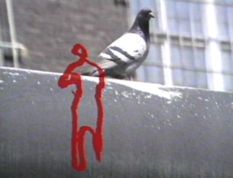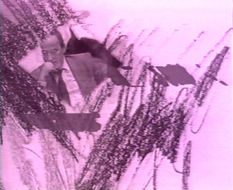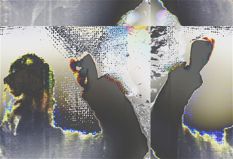



Sign Open by Beke Zsófia |
||||
Lux Antal has lived and worked in Berlin since 1956. He participated in the Graphic Colony of Artists in Makó. Besides painting, he is also involved in making videos from 1980. He is interested in science, mathematics, physics, the relativity theory of Einstein, chaos, the sure and the unsure, the occasional, the imagery, illusion, the difference of point of views, abstraction, the moving and the static, west and east, the differences of societies in his works. He does not intend to give an answer to these problems, still he provides a unique interpretation. Skeptic reflections and humor are both characteristics of his works. His early, mainly graphic works prove that Lux is not a video artist chiefly. His late video works show his fine artist veins and the gradual transformation of his view of the world. He often paints or draws on the frames; he manipulates them as an artist. Thus, he shows us a fast sequence by which he creates a virtual or impressionistic reality. His first video film made in 1981 was based on simple optic phenomena. Later he made more narrative videos. From the 80`s he often applied radio broadcastings or archive films. The videos made in the 90's show that their creator was not hypnotized by any of the genres. He always makes the audience make responsible decisions. The "Weisser Faden" (1992) is a 'road movie' in which the point of view of the driver and the pictures he imagines in his mind are varied parallel with the sounds, words and views. In this video, the plot and the reflection dialectically measure up. The "Glossolalie" (1991) is based on the phenomena of the "speaking language" on the often meaningless, non-articulated feature that may reach the evil ecstasy or idiotism. It was also the description of the reunion of the two Germanies. The topic of the "Mauerläufer" (1991) is the crossbreeding of the Wall of Berlin and the movements of two ballet dancers. In the 90's he often dealt with the Wall of Berlin full of graffiti (In "Hammelsterben", 1992), the Hungarian Revolution in 1956 and the loss of identity after the iron curtain came down ("Identität", 1991). The artist opened a time window through the spectacle and sounds. He follows the life of his neighbors through the window of his studio. ("1/61 Chamissoplatz", 1993). The "Fragmente" (1993) confronts the written and spoken world through the music of Kurtág György. The collages of the material he found and rearranging them according to his own view is the base of all his works. He models his videos as a sculptor. Ha makes them palpable. Fast, temporary and minute pictures all characterize his graphic works and videos. ("Proszenium", 1989). His video and electrographic series made in 1997 ("Gedanken zur Flugangst") visualize his fear of flying, his dread of academism with the method of association, the means of painters and computer graphics. His visual and painting language is to be used only once. He never repeats himself and his signs. He applies these elements freely, in his own system. He constantly changes the point from where he contemplates the world his works are free from schemes. It is a creative work full of inventions. (Contemporary Hungarian Arts Lexikon, Enciklopédia Press) Beke Zsófia
|
||||